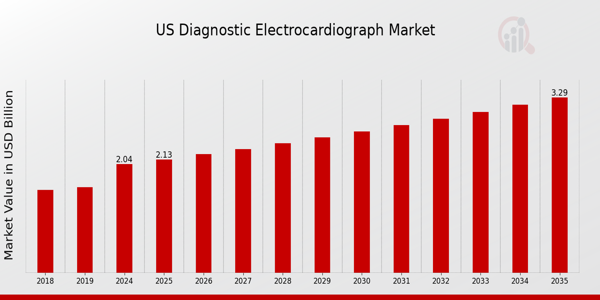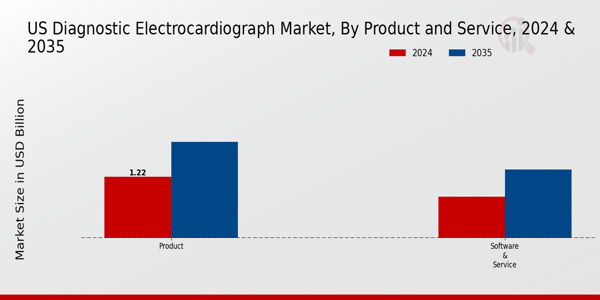US Diagnostic Electrocardiograph Market Overview
As per MRFR analysis, the US Diagnostic Electrocardiograph Market Size was estimated at 1.94 (USD Billion) in 2023. The US Diagnostic Electrocardiograph Market Industry is expected to grow from 2.04 (USD Billion) in 2024 to 3.29 (USD Billion) by 2035. The US Diagnostic Electrocardiograph Market CAGR (growth rate) is expected to be around 4.454% during the forecast period (2025 - 2035).
Key US Diagnostic Electrocardiograph Market Trends Highlighted
The US Diagnostic Electrocardiograph Market is witnessing significant trends driven by a growing focus on early disease detection and advancements in technology. Increasing incidences of cardiovascular diseases in the US, influenced by lifestyle changes and an aging population, are propelling the demand for reliable diagnostic tools like electrocardiographs.
As healthcare providers emphasize preventive healthcare strategies, the integration of telemedicine and remote monitoring solutions is gaining traction. This shift not only enhances patient access to care but also provides healthcare professionals with real-time data to improve decision-making.
There are ample opportunities in the US market as manufacturers explore innovations such as portable and wireless electrocardiograph devices. These devices are designed to cater to the demand for patient-centric solutions that allow for greater mobility and ease of use.
As more patients prefer to monitor their health from home, the expansion of smart wearable devices is another area poised for growth, aligning with the increasing interest in health technology among US consumers. Recent trends also show a rising collaboration between technology firms and healthcare providers to develop AI-driven electrocardiograph solutions.
These advancements lead to improved accuracy in diagnosing heart conditions, which is crucial given the high stakes involved. Regulatory bodies in the US are adapting to these changes, streamlining approval processes for innovative diagnostic technologies. This evolution presents a fertile ground for investments, signaling a promising future for stakeholders in the US Diagnostic Electrocardiograph Market.
Overall, the combination of technology advancements, shifting patient needs, and regulatory support makes this market dynamic and poised for continued growth.

Source: Primary Research, Secondary Research, Market Research Future Database and Analyst Review
US Diagnostic Electrocardiograph Market Drivers
Increasing Prevalence of Cardiovascular Diseases
Cardiovascular diseases remain the leading cause of death in the United States, accounting for approximately 697,000 deaths annually, which equates to about 1 in every 5 deaths, as reported by the Centers for Disease Control and Prevention (CDC). The growing incidence of conditions such as hypertension and heart attacks has exacerbated the demand for diagnostic tools, specifically Electrocardiographs.
As healthcare providers emphasize early detection and management of these diseases, the US Diagnostic Electrocardiograph Market Industry is positioned for substantial growth. Moreover, the American Heart Association (AHA) has projected that by 2030, nearly 43.9% of the adult population in the US will have some form of cardiovascular disease, further driving the need for efficient diagnostic solutions.
Technological Advancements in ECG Devices
The rapid advancement of technology is propelling innovation within the US Diagnostic Electrocardiograph Market Industry. Modern electrocardiograph devices are now equipped with features such as wireless connectivity, cloud data storage, and advanced algorithms for better accuracy and user-friendliness.
Research from the National Institutes of Health (NIH) indicates that incorporating artificial intelligence into ECG interpretation can enhance diagnostic precision by over 30%. Additionally, the integration of mobile health applications has allowed patients to monitor their heart health more effectively, increasing demand among both healthcare professionals and patients. This technological evolution is expected to further drive market adoption and growth in the coming years.
Rising Geriatric Population
The United States is witnessing a significant increase in its elderly population, projected to rise from 54 million in 2019 to over 80 million by 2040 according to the U.S. Census Bureau. This demographic shift is accompanied by a higher prevalence of cardiovascular conditions, necessitating advanced monitoring solutions such as Electrocardiographs.
The aging population tends to exhibit increased vulnerability to heart ailments, thereby creating a substantial demand for diagnostic equipment. Healthcare providers and organizations are now placing a strategic focus on adapting facilities and services to cater to the healthcare needs of older adults, greatly boosting the US Diagnostic Electrocardiograph Market Industry.
Increasing Focus on Preventive Healthcare
There is a growing trend towards preventive healthcare in the United States, which is driving the demand for diagnostic tools like Electrocardiographs. According to the U.S. Department of Health and Human Services, investing in preventive measures can save the healthcare system significant costs up to 5 billion dollars annually by reducing hospitalizations and emergency services.
Health education programs and awareness campaigns are leading to increased screening and diagnosis of cardiovascular diseases, making Electrocardiographs an essential tool for physicians. As more patients and healthcare providers prioritize preventive measures, the US Diagnostic Electrocardiograph Market Industry is expected to expand markedly to meet this emerging demand.
US Diagnostic Electrocardiograph Market Segment Insights
Diagnostic Electrocardiograph Market Product and Service Insights
The US Diagnostic Electrocardiograph Market has shown significant growth, particularly in the Product and Service segment, which plays a crucial role in advancing cardiovascular healthcare. The range of products includes various electrocardiograph machines that are designed to provide accurate and timely cardiac assessments, a necessity given the increasing incidence of heart diseases in the US.
These products are complemented by a multitude of software solutions that enhance the functionality and analysis capabilities of the electrical readings provided by the machines. Such software follows modern trends towards digital health, including telemedicine integrations that allow healthcare providers to access and interpret data remotely, thus improving patient outcomes and overall efficiency in care delivery.
Services within this segment facilitate the ongoing operation and maintenance of electrocardiograph equipment, ensuring that healthcare facilities can continue to rely on accurate diagnostic capabilities. With the advancements in technology, service offerings increasingly include training for medical personnel on the latest equipment and software, highlighting a growing emphasis on enhancing user competence and service delivery.
Given the regulatory nature of healthcare in the US, the Product and Service segment is also impacted by compliance requirements that demand high standards of safety and efficacy in diagnostic tools, pushing manufacturers to continuously innovate. Market trends indicate that the aging population and rising prevalence of chronic diseases are major growth drivers for the US Diagnostic Electrocardiograph Market.
As the healthcare landscape shifts towards more preventive care, the demand for advanced diagnostic tools and services is poised to increase. Meanwhile, emerging opportunities lie in the development of portable and wearable ECG devices, which provide patients with greater accessibility to cardiac health management.
Overall, the Product and Service segment is pivotal, not only in addressing current healthcare demands but also in paving the way for future innovations in cardiac diagnostics.

Source: Primary Research, Secondary Research, Market Research Future Database and Analyst Review
Diagnostic Electrocardiograph Market Lead Type Insights
The US Diagnostic Electrocardiograph Market, particularly in the Lead Type segment, showcases a diverse and essential classification of monitoring devices utilized for assessing cardiac activity. Among these, the 12-Lead configuration stands out as the traditional standard for comprehensive cardiac diagnosis, providing detailed insights regarding the heart's electrical activity.
The 5-Lead and 3-Lead types are increasingly preferred in emergency and monitoring settings due to their ease of use and portability, making them crucial in various healthcare environments. In addition, the 6-Lead and Single-lead systems cater to specific use cases, primarily for simpler screenings and patient monitoring, reflecting the ongoing trend towards more accessible healthcare solutions.
Other Lead Types also contribute significantly to the market, facilitating specific diagnostic requirements. This segmentation highlights not only the technological advancements made in cardiac monitoring but also the growing need for personalized and adaptive healthcare solutions in the US, driven by factors such as the rising prevalence of cardiovascular diseases and the increasing demand for effective remote patient monitoring solutions.
The alignment between healthcare innovations and the diverse Lead Type offerings positions this market as a critical component of the evolving landscape of cardiac care.
Diagnostic Electrocardiograph Market End User Insights
The US Diagnostic Electrocardiograph Market, particularly in the End User segment, reflects a diversified landscape that plays a critical role in cardiac care. Hospitals represent a significant portion of this segment, focusing on providing comprehensive diagnostic services to manage heart conditions, leveraging advanced technology and trained professionals to enhance patient outcomes.
Clinics and Cardiac Centers also contribute notably, serving as specialized hubs for patients seeking immediate or preventive cardiac assessments, which streamlines access to essential health services. Ambulatory Surgical Centers have gained increasing importance due to their ability to conduct outpatient procedures efficiently, thus reducing the burden on hospitals while promoting patient convenience.
Lastly, the category of Other End Users encompasses a variety of healthcare settings, highlighting the expanding utilization of diagnostic electrocardiographs across different environments. The growing prevalence of heart disease, coupled with an aging population in the US, drives the demand across these segments, creating abundant opportunities in the market while fostering advancements in technology and service delivery for improved patient experiences.
US Diagnostic Electrocardiograph Market Key Players and Competitive Insights
The US Diagnostic Electrocardiograph Market plays a crucial role in the healthcare industry, focusing on the essential function of monitoring and diagnosing cardiac health through sophisticated electrocardiographic devices. This market is characterized by a mix of established players and emerging companies that continuously innovate to improve diagnostic accuracy and patient outcomes.
The competitive landscape is influenced by technological advancements, regulatory changes, and shifts in healthcare policies associated with cardiac care. With an increasing prevalence of cardiovascular diseases and an aging population driving the demand for efficient cardiac monitoring solutions, companies in this sector are vying for market share through product differentiation, strategic partnerships, and expanded service offerings.
Companies are also investing heavily in research and development to enhance the capabilities of their electrocardiograph systems, which further intensifies competition. HillRom Holdings stands as a prominent player within the US Diagnostic Electrocardiograph Market, leveraging its extensive experience in healthcare solutions to enhance patient monitoring systems.
HillRom's strengths lie in its robust product portfolio that includes advanced ECG machines designed for both clinical and home healthcare settings. The company has established a strong foothold in the US market through strategic collaborations with medical facilities and a commitment to improving patient outcomes.
HillRom's focus on innovation ensures that it stays relevant in a rapidly evolving market, providing high-quality equipment that meets the needs of healthcare professionals. Their dependable service support, training programs, and customer relations further add to their competitive edge, allowing them to effectively respond to the dynamic needs of healthcare providers across the United States.
Medtronic has a significant presence in the US Diagnostic Electrocardiograph Market, known for its pioneering technology and comprehensive cardiac care solutions. This company offers a diverse range of ECG products and diagnostic services, which facilitate accurate heart monitoring and diagnostics.
Medtronic's strength lies in its continuous emphasis on research and development, constantly upgrading its product lineup to integrate the latest technological advancements. The company has engaged in strategic mergers and acquisitions to enhance its market presence and broaden its service capabilities, making it a formidable contender in the cardiac monitoring sector.
Its commitment to addressing complex healthcare challenges through innovative solutions positions Medtronic as a leader in the ECG space. By forging strong relationships with healthcare providers and focusing on patient-centered solutions, Medtronic aims to maintain and expand its influence within the US market.
Key Companies in the US Diagnostic Electrocardiograph Market Include
US Diagnostic Electrocardiograph Market Industry Developments
The US Diagnostic Electrocardiograph Market has seen notable developments recently. HillRom Holdings has invested in advancing telemetry solutions, while Medtronic has launched an innovative AI-assisted ECG system aimed at enhancing clinical efficiency. Schiller, along with other manufacturers, is focusing on improving portability and accessibility of electrocardiograph devices.
In September 2023, GE Healthcare announced a collaboration with Siemens Healthineers to integrate cloud-based analytics with ECG monitoring systems aimed at data management efficiencies. In terms of mergers and acquisitions, Cardinal Health announced in August 2023 that it would acquire a smaller diagnostic solutions company to expand its footprint in the ECG market, enhancing its product lineup.
This movement echoes a broader trend of consolidation within the industry, driven by increasing demand for integrated healthcare solutions. Recent market growth has been substantial, with estimates suggesting a value increase of approximately 10% year-on-year through 2023, motivated by the rising prevalence of cardiovascular diseases and a growing elderly population in the US.
Developments over the past few years have further emphasized the role of technology in improving patient diagnostics, evident from innovations and regulatory changes aimed at expanding ECG service accessibility.
US Diagnostic Electrocardiograph Market Segmentation Insights
Diagnostic Electrocardiograph Market Product and Service Outlook
Diagnostic Electrocardiograph Market Lead Type Outlook
Diagnostic Electrocardiograph Market End User Outlook
- Clinics & Cardiac Centers
- Ambulatory Surgical Centers
| Report Attribute/Metric Source: |
Details |
| MARKET SIZE 2018 |
1.94(USD Billion) |
| MARKET SIZE 2024 |
2.04(USD Billion) |
| MARKET SIZE 2035 |
3.29(USD Billion) |
| COMPOUND ANNUAL GROWTH RATE (CAGR) |
4.454% (2025 - 2035) |
| REPORT COVERAGE |
Revenue Forecast, Competitive Landscape, Growth Factors, and Trends |
| BASE YEAR |
2024 |
| MARKET FORECAST PERIOD |
2025 - 2035 |
| HISTORICAL DATA |
2019 - 2024 |
| MARKET FORECAST UNITS |
USD Billion |
| KEY COMPANIES PROFILED |
HillRom Holdings, Medtronic, Schiller, Cardinal Health, AccuTech, Philips, Siemens Healthineers, GE Healthcare, Rudolph Technologies, CardioComm Solutions, Nihon Kohden, QRS Diagnostic, Carestream Health, Biosense Webster |
| SEGMENTS COVERED |
Product and Service, Lead Type, End User |
| KEY MARKET OPPORTUNITIES |
Increasing telemedicine adoption, Aging population demand, Technological advancements in devices, Rising prevalence of cardiovascular diseases, Integration with wearable technology |
| KEY MARKET DYNAMICS |
Rising cardiovascular diseases, Technological advancements, Increasing geriatric population, Growing healthcare expenditure, Shift towards preventive healthcare |
| COUNTRIES COVERED |
US |
Frequently Asked Questions (FAQ):
The US Diagnostic Electrocardiograph Market is expected to be valued at 2.04 USD Billion in 2024.
The market is projected to grow at a CAGR of 4.454% from 2025 to 2035.
By 2035, the market is expected to reach a value of 3.29 USD Billion.
The Product segment is projected to be valued at 1.22 USD Billion in 2024.
The Software & Service segment is expected to reach a value of 1.37 USD Billion by 2035.
Key players include HillRom Holdings, Medtronic, Schiller, Cardinal Health, and Philips among others.
The market offers opportunities through technological advancement and increasing demand for diagnostic solutions.
Emerging trends include advancements in telemetry and integration with digital health platforms.
Challenges include regulatory compliance and high costs associated with advanced diagnostic equipment.
The competitive landscape will remain dynamic with key players strategizing for market share and innovation.















